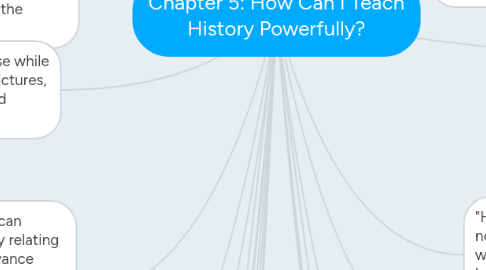Chapter 5: How Can I Teach History Powerfully?
by Lauren Murph


1. As a teacher, we may need to argue if concepts are not well developed as well as identify questions.
2. We study history to learn about human development through time and life at different places in the world; to learn about the origins and development of our country and its institutions and traditions; to understand the many ways in which todays world has been shaped by decisions and events in past; to understand how these past events influenced beliefs, attitudes, and life experiences.
3. As a child, I remember learning history in middle school. I thought it was very boring. Now that I think about it, I think it was because the content we were reading was boring.
4. History involves more than understanding of content, it involves a set of process skills.
4.1. Students need these skills to be able to draw their own conclusions about history.
5. The process standards are: chronological order, historical comprehension, historical analysis and interpretation, historical research capabilities, and historical issues-analysis and decision-making.
6. Tips for teaching history: focus instruction on the study of particular individuals and groups of people rather than on impersonal abstractions, represent historical material to students in the form of narratives, emphasize fostering empathy with the people being studied, expose students to various data sources, and guide students in their utilization of these sources.
7. Make sure to include racial, ethnic, and social class groups when teaching history.
7.1. I think this is very important. Students need to experience different views to fully understand.
8. The most natural and motivating way to introduce children to history is to use their own family history.
8.1. I love this idea because it makes the content and the process very personal. This way it makes it easy to understand and process because it is related to their lives.
9. Most history is embedded in the storyline usually developed by the teacher.
10. If literature is well chosen, it can provide a sense of context by relating significant purposes that advance historical understanding, provide a sense of relation of how some people share about their world, help students learn to accept the view of others, and exposes them to interpretations of events.
11. Timelines are helpful to assist students with remembering landmarks. Teachers can create timelines while learning history and keep it posted in the classroom.
11.1. I love this idea of working on a timeline gradually while teaching. I will use this in my classroom.
12. Some other good tools to use while teaching history is games, pictures, puzzles, songs, cartoons, and illustrations.
13. At first, children do not understand the relationship of not event to another .
13.1. Children view changes as unrelated.
13.1.1. Children gradually understand that evidence must be interpreted.
